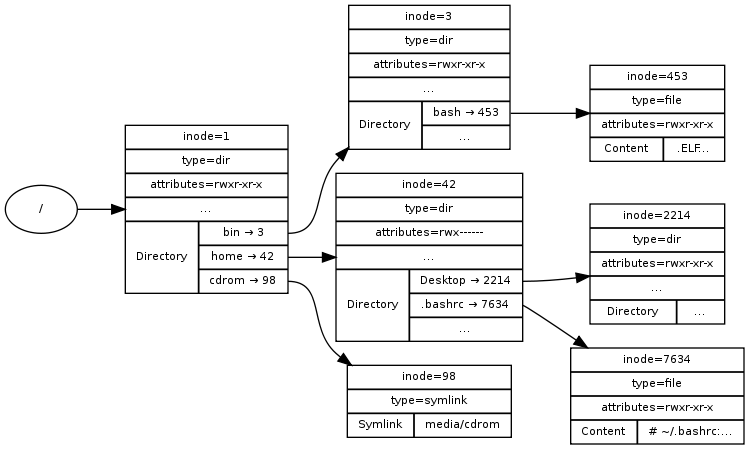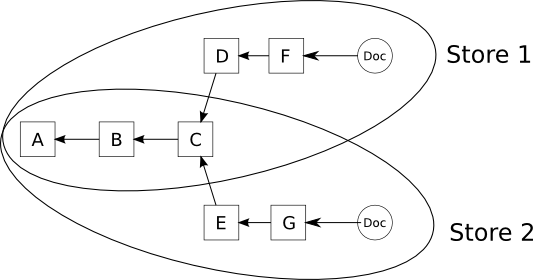-
Notifications
You must be signed in to change notification settings - Fork 1
Understanding peerdrive
PeerDrive tries to solve various problems which are common to every day file management but which are poorly supported by traditional hierarchical file systems. In particular these are:
- Replication and synchronization
- Seamless backup integration
- File versioning
- Arbitrary, non-hierarchical file organization
- Annotation (e.g. tags) and rich meta data
These problems are tackled by three main concepts in PeerDrive:
In traditional hierarchical file systems a file is identified by its path. Normally this means that if two paths differ then they identify two different files (excluding sym-/hard links at this point). The problem with this scheme is that it not only gives the file its identity but it also represents the users classification/organization of the file. If the user moves the file to another folder (to change the classification) he will also implicitly change the identity of the file. Usually the user observes the effect of the changed identity by broken symbolic links or non-working “Recent files” entries in applications.
Even though these effects can be mitigated by good user interfaces and additional software layers they are not solvable on the file system level. Furthermore only strict categorization schemes are supported as organizing principle. A file can only live in one category (folder) at the same time. Hard links can overcome this situation but they only work for files on the same volume and not for directories. Symlinks work for both files and directories but break as soon as the original file is moved.

In PeerDrive every document (file) is identified by a 128 bit random unique id (DId). Any document can “point” to another document by it’s DId, even across volume boundaries. This allows for arbitrary organization schemes via “container” documents. The documents can be moved even between volumes (called ‘stores’ in PeerDrive) without breaking the links between them.

The same document (DId) may also exist on more than one store simultaneously. This is no error and is a common state when documents are replicated between different stores. In conjunction with versioning PeerDrive is later able to synchronize the replicas on the different stores.
The content of each document is stored as a series of immutable revisions as opposed to a mutable byte stream in traditional file systems. For this scheme each store maintains a mapping of document IDs to the latest revision of the document where each revision is identified by the hash of its content. This is the same scheme as git is using to track changes to the repository.
As a document can exist is more than one store simultaneously it’s history may not be linear and can contain forks. See the following picture for an illustration of what happens when a document is replicated and changed independently on the different stores.

If the user chooses to synchronize the two versions of the same document PeerDrive is able to find the common ancestor © and merge the independent changes into one version automatically. After the merge the document exists on both stores with the same revision and the same history.

Another big advantage for the user is that he is always able to access previous revisions of the document. As long as old revisions are not purged the user does not need to care about overwriting the document and loosing important data.
Additionally this allows for a seamless integration of backups. Old revisions which are not needed anymore may be moved to a backup store. If such an old revision is needed again only the backup store needs to be mounted because PeerDrive does not care on which store a revision is located. Therefore normal document handling and backup are seamlessly integrated in PeerDrive.
In traditional file systems a file is just a stream of bytes with a limited amount meta data (file name, size, c-/m-/atime, access rights). Later extended attributes were added which are user definable key/value pairs, where keys are usually strings and values again streams of bytes. BeOS added indexing of these
extended attributes and used them extensively for file management.
PeerDrive takes the concept even further and allows arbitrarily complex meta data. This includes key/value pairs but also lists, links to other documents, booleans, integers, floats and strings. Semantically this is close to JSON or other structured data representations. This allows for unrestricted, extensible annotation of documents by the user or applications. Together with indexing of this meta data the user is able to quickly find documents based on this meta data.
All meta data, that is including the file name, is stored with the document. In traditional file systems the file name is given by the directory whereas extended attributes are stored in the inode (the file itself). Furthermore each additional hardlink created a new file name. Renaming one of the hard links is not visible on the other hard links.
Once a new revision of a document is created it cannot be overwritten anymore. It can just be superseeded by another, newer revision while the old revision is still kept. But sometimes it is desireable to just replace a revision, though.
This can be done by saving the current document state as a preliminary revision. Such revisions will never be replicated because they will eventually be replaced or deleted. There can be also be more than one preliminary revision per document.
Every document in PeerDrive is typed by an Uniform Type Identifier (UTI).
PeerDrive documents consist of one or more parts, each identified by a FourCC. This is roughly equivalent to forks in file systems (Resource forks / Alternate Data Streams). The main difference to other file systems is that all parts are handled together instead of being treated as almost independent files.